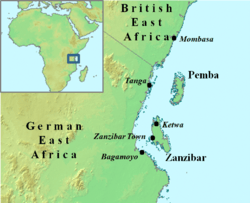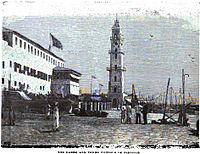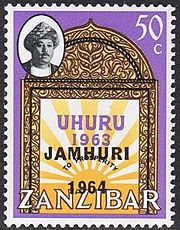Sultanate of Zanzibar facts for kids
Quick facts for kids
Sultanate of Zanzibar
|
|||||||||
|---|---|---|---|---|---|---|---|---|---|
| 1856–1964 | |||||||||
|
Anthem: "National Anthem of Zanzibar"
(Until 1890) "National March for the Sultan of Zanzibar" (1911–1964) |
|||||||||
| Status | Sovereign state (1856–90) British protectorate (1890–1963) Sovereign state (1963–64) |
||||||||
| Capital | Stone Town | ||||||||
| Common languages | Swahili, Arabic, English | ||||||||
| Religion | Islam | ||||||||
| Government | Absolute monarchy (1856–1963) Constitutional monarchy (1963–1964) |
||||||||
| Sultan | |||||||||
|
• 1856–1870
|
Majid bin Said (first) | ||||||||
|
• 1963–1964
|
Jamshid bin Abdullah Al Said (last) | ||||||||
| Chief Minister | |||||||||
|
• 1961
|
Geoffrey Lawrence | ||||||||
|
• 1961–1964
|
Muhammad Hamadi | ||||||||
| History | |||||||||
|
• Established
|
19 October 1856 | ||||||||
|
• Disestablished
|
12 January 1964 | ||||||||
| Population | |||||||||
|
• 1964
|
300,000 | ||||||||
| Currency | Zanzibari ryal (1882–1908) Zanzibari rupee (1908–1935) East African shilling (1935–1964) Indian rupee and Maria Theresa thaler also circulated |
||||||||
|
|||||||||
| Today part of | Kenya Tanzania Mozambique |
||||||||
The Sultanate of Zanzibar (Swahili: Usultani wa Zanzibar, Arabic: سلطنة زنجبار, romanized: Sulṭanat Zanjībār) was a country ruled by the Sultan of Zanzibar. It existed from 1856 to 1964.
At its largest, the Sultanate controlled all of what is now Kenya and the Zanzibar Archipelago. Over time, its territory became smaller. Eventually, it only ruled the islands of Zanzibar and a narrow strip of land along the Kenyan coast. The rest of Kenya became the British Kenya Colony.
On October 8, 1963, the Sultan gave up his control over the mainland territory. Kenya became independent from the British on December 12, 1963. A month later, on January 12, 1964, Jamshid bin Abdullah, the last sultan, was removed from power. This event marked the end of the Sultanate of Zanzibar.
Contents
History of the Sultanate
How the Sultanate Began
In 1698, Zanzibar became part of the Omani Empire after Oman defeated the Portuguese. In 1832 or 1840, the Omani ruler, Said bin Sultan, moved his main court from Muscat to Stone Town on Unguja island (Zanzibar Island).
He created a ruling group of Arabs and encouraged the growth of clove farms. These farms used enslaved labor. Traders from India also came to Zanzibar, and Said encouraged them to settle there. They became very important in trade.
After Said bin Sultan died in 1856, his two sons, Majid bin Said and Thuwaini bin Said, argued over who would rule next. Because of this, Zanzibar and Oman became two separate countries. Thuwaini became the Sultan of Muscat and Oman, and Majid became the first Sultan of Zanzibar. Majid had to pay money to Oman each year.
During his 14 years as Sultan, Majid became very powerful through the local Arab slave trade. His successor, Barghash bin Said, worked to end the slave trade in Zanzibar. He also greatly improved the country's roads and buildings. The third Sultan, Khalifa bin Said, also helped to stop slavery.
Zanzibar's Loss of Control
Until 1884, the Sultans of Zanzibar controlled a large part of the Swahili coast and trade routes deep into Africa. However, in 1884, the Society for German Colonization made local chiefs on the mainland agree to German protection. Sultan Bargash bin Said protested this.
Around the same time, the Berlin Conference was happening, where European powers divided up Africa. Germany became more interested in the area. In 1885, the new German East Africa Company arrived, aiming to colonize the region.
In 1886, Britain and Germany secretly met to discuss their plans for expansion in the African Great Lakes region. They had already agreed on areas of influence the year before. Britain would take what is now Kenya, and Germany would take present-day Tanzania. Both countries rented coastal land from Zanzibar and set up trading posts.
Over the next few years, European powers took control of all of Zanzibar's mainland territories. This started in 1888 when the Imperial British East Africa Company took over Mombasa. In the same year, the German East Africa Company gained direct rule over the coastal area that was under German protection. This led to a local uprising, the Abushiri revolt, which was stopped by the German navy. This marked the end of Zanzibar's power on the mainland.
British Control Begins (1890)

In 1890, Britain and Germany signed the Heligoland-Zanzibar Treaty. This agreement made Zanzibar a British protectorate. This meant Britain would protect Zanzibar, but the Sultan still ruled.
In August 1896, after Sultan Hamad bin Thuwaini died, Britain and Zanzibar fought a very short war. It lasted only 38 minutes, making it the shortest war in recorded history. The Sultan's cousin, Khalid bin Barghash, tried to take power. However, the British wanted Hamoud bin Mohammed to be Sultan, as they believed he would be easier to work with.
The British gave Khalid one hour to leave the Sultan's palace. Khalid refused and gathered an army of 2,800 men. The British attacked the palace and other places in the city. Khalid then fled and went into exile. Hamoud was then peacefully made Sultan.
British East Africa Protectorate (1895)
In 1886, the British government encouraged William Mackinnon to increase British influence in the region. Mackinnon's shipping company already traded a lot in the African Great Lakes. He formed a British East Africa Association. This led to the Imperial British East Africa Company being formed in 1888. This company was given the right to manage the territory.
The company managed about 240 kilometers (150 miles) of coastline. This area stretched from the Jubba River through Mombasa to German East Africa. This land was leased from the Sultan. Britain's "sphere of influence" (area of control) extended up the coast and inland into what would become Kenya. After 1890, it also included Uganda. Mombasa was the main administrative center at this time.
However, the company started to struggle. So, on July 1, 1895, the British government declared a protectorate called the East Africa Protectorate. The administration was then moved to the Foreign Office. In 1902, it moved again to the Colonial Office. The Uganda territory was also included in this protectorate.
In 1897, Lord Delamere, a pioneer of white settlement, arrived in the Kenya highlands. He was impressed by the farming possibilities there. In 1902, the protectorate's borders were expanded to include what was once the Eastern Province of Uganda. Also in 1902, the East Africa Syndicate received a large land grant to encourage white settlement in the Highlands. Lord Delamere began large farming operations. In 1905, many immigrants arrived from Britain and South Africa. The capital was moved from Mombasa to Nairobi in 1905. A formal government was set up in 1906.
Sultan Loses Kenya Mainland (1920)
On July 23, 1920, the inland areas of the East Africa Protectorate became British territory. This part was then called the Colony of Kenya. From this time on, the Sultan of Zanzibar no longer ruled over that land.
The remaining 16-kilometer (10-mile) wide coastal strip (except for Wituland) stayed a Protectorate under an agreement with the Sultan of Zanzibar. This coastal strip, still under the Sultan's rule, was called the Protectorate of Kenya in 1920.
The Protectorate of Kenya was governed as part of the Colony of Kenya. So, the "Colony of Kenya" was the inland land, and the "Protectorate of Kenya" was the coastal strip. The coastal strip remained under the Sultan's rule until Kenya became independent.
Kenya's Independence (1963)
Both the Colony of Kenya and the Protectorate of Kenya ended on December 12, 1963. The United Kingdom gave up its rule over the Colony of Kenya. Also, under an agreement from October 8, 1963, the Sultan agreed to give up his rule over the Protectorate of Kenya when Kenya became independent. This is how Kenya became an independent country. Exactly one year later, on December 12, 1964, Kenya became a republic called the "Republic of Kenya."
End of Zanzibar Protectorate (1963-1964)
On December 10, 1963, the British Protectorate over Zanzibar ended. The United Kingdom did not "grant" Zanzibar independence because Britain never fully owned Zanzibar. Instead, the UK ended its protection, allowing Zanzibar to become a self-governing, independent country within the Commonwealth.
After the Protectorate ended, Zanzibar became a constitutional monarchy with the Sultan as its head. However, Sultan Jamshid bin Abdullah was overthrown a month later during the Zanzibar Revolution. Jamshid went into exile, and the Sultanate was replaced by the People's Republic of Zanzibar. In April 1964, this new republic joined with Tanganyika to form the United Republic of Tanganyika and Zanzibar. Six months later, this country became known as Tanzania.
People of Zanzibar
By 1964, Zanzibar was a constitutional monarchy ruled by Sultan Jamshid bin Abdullah. Zanzibar had about 230,000 native people. Some of them said they had Persian ancestors and were called Shirazis.
There were also many minority groups, including 50,000 Arabs and 20,000 South Asians. These groups were very important in business and trade. The different ethnic groups were mixing, and the differences between them were becoming less clear. Some historians say that people supported Sultan Jamshid because his family had different ethnic backgrounds.
However, the Arab people on the island owned most of the land and were generally richer than the native people. The main political parties were mostly organized by ethnic group. Arabs mainly supported the Zanzibar Nationalist Party (ZNP), and native people mainly supported the Afro-Shirazi Party (ASP).
Images for kids
See also
 In Spanish: Sultanato de Zanzíbar para niños
In Spanish: Sultanato de Zanzíbar para niños










